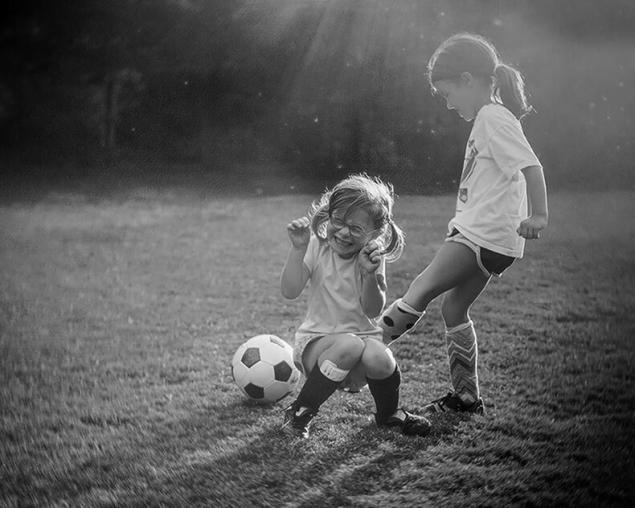751
Children with a STRONG WILL: what you need to know
Children quite can vary in nature. They, like adults, have a unique set of qualities that set them apart from others, to give life advantages or, conversely, impede the existence. But the surprising thing is that even the positive trend can turn of advantages in the complexity of nature, if nature has given too much.
Is it good to have a strong character and indomitable will? "Yes, certainly!" I will say most of the adult. Because so many, sometimes not enough willpower in everyday life. But how will power should be strong, and how it can manifest itself in a child?
Among children's "difficult characters" are the so-called "bratty kids" or "children with a strong will". In General they can be described in a rather positive colors. They are confident, persistent and positive creation. However, they often bring their parents a lot of difficulties, trouble, and quite removed from the balance.

This is because the previous three positive qualities - confidence, perseverance and a positive attitude - are and side effects:
1. The child cannot be forced to do something strongly, if he does not want to do. If he doesn't want to eat Breakfast or to go outside, no requests and stunts can't make him talk or draw as long as he so decides.
2. Does everything himself and always strives to make himself even if he is clearly not right (high, hard, requires skill) and refuses to accept help.
3. Requires constant attention. If he wants to sit on his lap or play with mom, to turn away from this desire or offer something otherwise impossible.
4. He wants to make decisions. He knows what to buy, what to eat for Breakfast, what to wear and where to go. Options are not acceptable, even if the decision of the child beyond reasonable.
5. Does not recognize the authority of parents: he for himself the authority. Often opposes discipline.
6. Persistent in achievements. If you have something banned or put beyond his reach, he with varying degrees of intensity to try to achieve this or to do that.
7. The child is unpredictable. If he decided something, nobody advises, just do it yourself.
8. Insists on its decision, whatever it may be. Or do "it" or nothing.
9. For any remark on the part of the parents responds with a remark in their direction, "contradict". Not listening to their instructions, and himself points out that for parents to do.
10. Periodically exhibits extreme sensitivity and emotionality.
11. At the age of 1.5-2 years are more likely than other children outbursts of anger (tantrum).
12. The failures may give pronounced negative reaction (screaming, crying, aggression), but to keep trying to run the business. Even able to do some frustrarion thing to stop, with cries and tears, but will see it to the end or will do until you get it the way he wants to.
13. Knows no boundaries. If a normal child after a few repetitions is enough to identify the border of conduct in any particular place, the child with a strong will repeatedly try to break it or expand. You can say 100 times that in the store or public transport not to scream. He would scream and not from a misunderstanding of what you require from him. He will cease to do only when he wants.
14. Can use screaming, screeching and crying, not talking, until the child gets what she wants.
15. Maybe harder to master individual skills (e.g. a pot) ' from principle.
16. In the collective dominant and confident.
17. Not afraid to ask questions and asks quite a lot about what and how is how it works.
18. Insensitive to pain. Falling quite heavily, or filling cones may stand up as if nothing had happened, and continue playing or to go where he was going.

For such children is characteristic of high reactivity (they abruptly and violently react to any restrictions, prohibitions, and conditions). But at the same time, children with strong will have very high adaptability. They explore the world with perseverance and stubbornness, which are the envy of adults. All the disadvantages described above typically arise as a result of the General immaturity of the brain and inability to control emotions. In addition, children at this age are not really aware of their capabilities and limitations.
Moreover, quite interestingly, the more the child to push, the more he is stubborn and resists. He wants to overcome the frustration of all the forces. In other words, the more parents try to punish the stronger he gets, the more desperate he gets.
Such a child can be seen in infancy. It can give quite a pronounced negative reaction, if he needs attention or some other need (brought it to a place that he doesn't like, or he wants somewhere in another place) he would scream until blue in the face, while the surrounding does not understand what he wants and do as he wants. To distract, to take others, to feed, to pump or to do what works for other babies, absolutely useless.
These children have a relatively fast development, before becoming aware of itself as a separate identity and the crisis of 2-3 years they begin 1-1. 5. This is achieved insistent mastery of individual skills. But these skills also have a child chooses. Sitting or standing he will try again through the fall and bruises, with incredible persistence and willpower. This training of motor skills is very different from the "average" tempo of their development normal children. Later, when the range of interests is expanding, the child embodies their perseverance in games. If it is a collection of the pyramid, so the pyramid will be collected until you drop. Cubes while collecting pyramid does not offer. If a child wants to walk with daddy and go with him to the hill, options such as "grandma on the swing", are not satisfied in any way.
The complexity of these children is that, as I wrote, they are largely frustrert parents. That is, the child is beautiful, kind, positive and smart, while its intentions coincide with the parent. But if he wants another, no carrot and stick not to turn away from his intentions. Parents begin to insist, the child resists... Parents insist further, child — even more to resist. Parents who believe that, in the end, the child must agree that sometimes comes to violence and extreme restrictive measures. Measures, in turn, also do not help. The child may develop a pattern of behavior, leading to a constant breach of discipline. It seems that this is the only way to interact with society. In other words, in the struggle with the parents and the child may own a fairly large potential to turn against himself.
What to do?
The only way to communicate with such child – rearing, namely the training of social interaction, despite his need to do what he wants. In addition, the formation of these skills will help the child to realize their quality for the benefit of themselves and not harm.
What is important to know:
1. Outside of acute situations confront the child, it is important to show how to interact with people, and what can happen from different types of interactions. Something leads to trouble, and something leads to use. Of course, that one story will not solve the problems, and this practice must be commonplace. Useful stories and tales, or any other example that can be borrowed from everyday life.
2. Practice reinforcement. Positive behaviour should be supported. But if we teach the child social interactions, and reinforcement should be of the same nature. This is words of affirmation, praise, hugs, kisses and smiles. Bad behavior should be ignored. Of course, this applies to those cases when the child is not doing what is strictly forbidden (violates the rules) or dangerous for him and others. In fact, the reaction to the bad behavior causes the child to protest and will cope with it. The lack of reaction to a lesser degree provokes him to by whatever actions.
3. Not to go on about the desires that are contrary to your views. If it does, in fact, parents reinforce the unwanted behavior, and do not substantiate desired.
4. You need to create an enabling environment that provokes the child. If you do not want your child to take some things or interacted with any people or animals, it is best things to remove, and contacts to avoid. Again, this only applies to items and contacts that do not limit or alter the life of the whole family. I.e. you can remove breakable and valuable Souvenirs and utensils out of the reach of the child.
5. The child needs to learn to calm down independently and solved the problem available to him and safe ways. If the child wants you to cook, you can give it a feasible task. For example, add chopped vegetables in a bowl or peel boiled eggs, feeding spoons.
6. When you need your child to do what you want, for example, gave you a hand when crossing the street, need no demonstration of aggression and anger hard to take his hand and move, despite the protests. After task execution, back crossing the road hand and said, "great! You went with the mother's hand".
7. You must provide clear instructions of what behavior is and when you want him to see. These requirements should be uniform for the entire family. Ie, mom and dad need to have a General opinion. And to avoid leaving a child's place to interpret the words of the parents through the offer of "philosophical discussion on the topic of good and bad behavior."
8. As punishment (and in fact, for simple reducing emotional stress) are used timeouts. Often, parents as primary determinants of the boundaries are subjected to constant attacks and challenges.
The punishment scheme consists of several steps. First, we must clearly demand to stop the undesirable behavior; second, to warn about the possibility of a timeout for insubordination; third, — in fact, a time-out. Perhaps (if the child is small) just to take my daughter to a separate room and close the door. Don't lock up and close so that the child could get out. I'll turn off the light, or other actions that may frighten or cause an additional wave of protest. If the child leaves the room restless, need to get him back into the room. As a rule, deprived of room facilities, setting limits, child quickly calms down.
More adult children need to make a 3-5 minute rest. The child in this case is seated on a chair in front of him and put the timer on a time defined by the parents. After the time is up, the child can get up and go about their business. If the child escapes or is cheating with timer, time, due to reset.
9. The house must be created a trusting and positive atmosphere. Family members positively evaluated, supported and encouraged. This greatly affects what the child sees as normal relations and to aspire to.
10. Parents should improve your communication skillsI and communication. Namely:
This is a simulation of the behavior of the child and teaching him more adaptive ways of organizing contacts with the society.
In other words, the work is hard, but worth it. These children with the right approach, have great potential and a lot to achieve. All efforts in education is an investment in the future of your child. published Author: Natalia Stilson P. S. And remember, just changing your mind — together we change the world! ©
Source: family-rambler.livejournal.com/126991.html
Is it good to have a strong character and indomitable will? "Yes, certainly!" I will say most of the adult. Because so many, sometimes not enough willpower in everyday life. But how will power should be strong, and how it can manifest itself in a child?
Among children's "difficult characters" are the so-called "bratty kids" or "children with a strong will". In General they can be described in a rather positive colors. They are confident, persistent and positive creation. However, they often bring their parents a lot of difficulties, trouble, and quite removed from the balance.

This is because the previous three positive qualities - confidence, perseverance and a positive attitude - are and side effects:
1. The child cannot be forced to do something strongly, if he does not want to do. If he doesn't want to eat Breakfast or to go outside, no requests and stunts can't make him talk or draw as long as he so decides.
2. Does everything himself and always strives to make himself even if he is clearly not right (high, hard, requires skill) and refuses to accept help.
3. Requires constant attention. If he wants to sit on his lap or play with mom, to turn away from this desire or offer something otherwise impossible.
4. He wants to make decisions. He knows what to buy, what to eat for Breakfast, what to wear and where to go. Options are not acceptable, even if the decision of the child beyond reasonable.
5. Does not recognize the authority of parents: he for himself the authority. Often opposes discipline.
6. Persistent in achievements. If you have something banned or put beyond his reach, he with varying degrees of intensity to try to achieve this or to do that.
7. The child is unpredictable. If he decided something, nobody advises, just do it yourself.
8. Insists on its decision, whatever it may be. Or do "it" or nothing.
9. For any remark on the part of the parents responds with a remark in their direction, "contradict". Not listening to their instructions, and himself points out that for parents to do.
10. Periodically exhibits extreme sensitivity and emotionality.
11. At the age of 1.5-2 years are more likely than other children outbursts of anger (tantrum).
12. The failures may give pronounced negative reaction (screaming, crying, aggression), but to keep trying to run the business. Even able to do some frustrarion thing to stop, with cries and tears, but will see it to the end or will do until you get it the way he wants to.
13. Knows no boundaries. If a normal child after a few repetitions is enough to identify the border of conduct in any particular place, the child with a strong will repeatedly try to break it or expand. You can say 100 times that in the store or public transport not to scream. He would scream and not from a misunderstanding of what you require from him. He will cease to do only when he wants.
14. Can use screaming, screeching and crying, not talking, until the child gets what she wants.
15. Maybe harder to master individual skills (e.g. a pot) ' from principle.
16. In the collective dominant and confident.
17. Not afraid to ask questions and asks quite a lot about what and how is how it works.
18. Insensitive to pain. Falling quite heavily, or filling cones may stand up as if nothing had happened, and continue playing or to go where he was going.

For such children is characteristic of high reactivity (they abruptly and violently react to any restrictions, prohibitions, and conditions). But at the same time, children with strong will have very high adaptability. They explore the world with perseverance and stubbornness, which are the envy of adults. All the disadvantages described above typically arise as a result of the General immaturity of the brain and inability to control emotions. In addition, children at this age are not really aware of their capabilities and limitations.
Moreover, quite interestingly, the more the child to push, the more he is stubborn and resists. He wants to overcome the frustration of all the forces. In other words, the more parents try to punish the stronger he gets, the more desperate he gets.
Such a child can be seen in infancy. It can give quite a pronounced negative reaction, if he needs attention or some other need (brought it to a place that he doesn't like, or he wants somewhere in another place) he would scream until blue in the face, while the surrounding does not understand what he wants and do as he wants. To distract, to take others, to feed, to pump or to do what works for other babies, absolutely useless.
These children have a relatively fast development, before becoming aware of itself as a separate identity and the crisis of 2-3 years they begin 1-1. 5. This is achieved insistent mastery of individual skills. But these skills also have a child chooses. Sitting or standing he will try again through the fall and bruises, with incredible persistence and willpower. This training of motor skills is very different from the "average" tempo of their development normal children. Later, when the range of interests is expanding, the child embodies their perseverance in games. If it is a collection of the pyramid, so the pyramid will be collected until you drop. Cubes while collecting pyramid does not offer. If a child wants to walk with daddy and go with him to the hill, options such as "grandma on the swing", are not satisfied in any way.
The complexity of these children is that, as I wrote, they are largely frustrert parents. That is, the child is beautiful, kind, positive and smart, while its intentions coincide with the parent. But if he wants another, no carrot and stick not to turn away from his intentions. Parents begin to insist, the child resists... Parents insist further, child — even more to resist. Parents who believe that, in the end, the child must agree that sometimes comes to violence and extreme restrictive measures. Measures, in turn, also do not help. The child may develop a pattern of behavior, leading to a constant breach of discipline. It seems that this is the only way to interact with society. In other words, in the struggle with the parents and the child may own a fairly large potential to turn against himself.
What to do?
The only way to communicate with such child – rearing, namely the training of social interaction, despite his need to do what he wants. In addition, the formation of these skills will help the child to realize their quality for the benefit of themselves and not harm.
What is important to know:
1. Outside of acute situations confront the child, it is important to show how to interact with people, and what can happen from different types of interactions. Something leads to trouble, and something leads to use. Of course, that one story will not solve the problems, and this practice must be commonplace. Useful stories and tales, or any other example that can be borrowed from everyday life.
2. Practice reinforcement. Positive behaviour should be supported. But if we teach the child social interactions, and reinforcement should be of the same nature. This is words of affirmation, praise, hugs, kisses and smiles. Bad behavior should be ignored. Of course, this applies to those cases when the child is not doing what is strictly forbidden (violates the rules) or dangerous for him and others. In fact, the reaction to the bad behavior causes the child to protest and will cope with it. The lack of reaction to a lesser degree provokes him to by whatever actions.
3. Not to go on about the desires that are contrary to your views. If it does, in fact, parents reinforce the unwanted behavior, and do not substantiate desired.
4. You need to create an enabling environment that provokes the child. If you do not want your child to take some things or interacted with any people or animals, it is best things to remove, and contacts to avoid. Again, this only applies to items and contacts that do not limit or alter the life of the whole family. I.e. you can remove breakable and valuable Souvenirs and utensils out of the reach of the child.
5. The child needs to learn to calm down independently and solved the problem available to him and safe ways. If the child wants you to cook, you can give it a feasible task. For example, add chopped vegetables in a bowl or peel boiled eggs, feeding spoons.
6. When you need your child to do what you want, for example, gave you a hand when crossing the street, need no demonstration of aggression and anger hard to take his hand and move, despite the protests. After task execution, back crossing the road hand and said, "great! You went with the mother's hand".
7. You must provide clear instructions of what behavior is and when you want him to see. These requirements should be uniform for the entire family. Ie, mom and dad need to have a General opinion. And to avoid leaving a child's place to interpret the words of the parents through the offer of "philosophical discussion on the topic of good and bad behavior."
8. As punishment (and in fact, for simple reducing emotional stress) are used timeouts. Often, parents as primary determinants of the boundaries are subjected to constant attacks and challenges.
The punishment scheme consists of several steps. First, we must clearly demand to stop the undesirable behavior; second, to warn about the possibility of a timeout for insubordination; third, — in fact, a time-out. Perhaps (if the child is small) just to take my daughter to a separate room and close the door. Don't lock up and close so that the child could get out. I'll turn off the light, or other actions that may frighten or cause an additional wave of protest. If the child leaves the room restless, need to get him back into the room. As a rule, deprived of room facilities, setting limits, child quickly calms down.
More adult children need to make a 3-5 minute rest. The child in this case is seated on a chair in front of him and put the timer on a time defined by the parents. After the time is up, the child can get up and go about their business. If the child escapes or is cheating with timer, time, due to reset.
9. The house must be created a trusting and positive atmosphere. Family members positively evaluated, supported and encouraged. This greatly affects what the child sees as normal relations and to aspire to.
10. Parents should improve your communication skillsI and communication. Namely:
- to listen carefully and not interrupt;
- not to monopolize the conversation (only one speaks and initiates topics of conversation, the outcome and direction);
- not to judge others and not to engage in moralizing, especially for the eye.
- during conflicts not to bring arguments from past deeds (that's what you in 1812 did this and now want something);
- solutions unpleasant situations should focus not on the search for the perpetrators, and seeking solutions;
- to use mutual compliments during intercourse;
- do not use "mind reading" in communion;
- not to Express disrespect or "lowering" of other family members;
- do not give mixed messages (to praise with a sour face or read a book and say that I like the picture of the child, which didn't even look).
This is a simulation of the behavior of the child and teaching him more adaptive ways of organizing contacts with the society.
In other words, the work is hard, but worth it. These children with the right approach, have great potential and a lot to achieve. All efforts in education is an investment in the future of your child. published Author: Natalia Stilson P. S. And remember, just changing your mind — together we change the world! ©
Source: family-rambler.livejournal.com/126991.html
Volkswagen to show electric car with a large power reserve
Named the most popular electric cars of Russia























